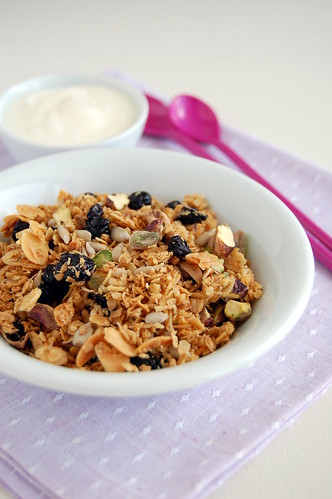
Image : http://www.flickr.com
Beef jerky is a snack at least since Egyptian known. Previously animals for meat, people eat dried together at all times, such as bears, bison, or even a whale. ground dried meat mixed with dried fruit or suet to the Indians of North America "pemmican." Biltong "is actually a dried meat of many countries in Africa. Our word" jerky "comes from the word" Spanish steps.
Beef jerky is a product which is amoisture-rich nutrients to meat products from drying easy. One pound of meat or poultry weighs about four ounces, after moving (most manufacturers will be sugar, spices and other items added to compensate). Due to the fact that the humidity up to "safe levels" removed, it is stable as a shelf. It can be stored without refrigeration - makes an ideal food for backpackers and others who have no access to refrigerators.
WithCommercial Beef Jerky products, the process in plants is federally controlled by inspectors from the UP Department of Agriculture for food security monitoring and verification service. The products can be treated or to be believed, can be smoked and dried or smoked at the United Nations, air or kiln dried. In industrial plants, are meat and the internal temperature and the percentage of water activity ( another) continues to be validated in order to regulate the process and ensure quality safeConsumer Products.
When raw meat or poultry is dehydrated at home, usually slightly open a hot oven or dryer, you must understand that you can make beef jerky from store shelf, but that all pathogenic bacteria likely to survive the dry heat a stove, and in particular the 130-140 F degrees for a typical dryer at low prices. This means that if the meat was contaminated in some way or had bought something in your process,contamination was to have imported meat, you have a high probability that the finished product in ruins after the dehydration process. If meat is not contaminated, and leave as a classic, you'll have no problem.
Illness related to salmonella and E. coli from home jerky raise further questions about the safety of traditional drying methods for the preparation of dried meat and wild game. The USDA Meat and Poultry Hotline current recommendationdried meat for the production of safety, meat and poultry to heat 160 ° F to 165 ° F before starting the drying process. This step ensures that all bacteria are destroyed by moist heat. Most dehydrator instructions do not include this step, and a dehydrator not reach temperatures high enough to be meat to 160 degrees F. After heating, the heat to maintain a constant temperature of 130-140 ° C for dehydrator drying is important because the process must be fast enoughPower dry before booty, and must remove enough water that microorganisms do not grow.
The risk of dehydration of meat and poultry without cooking to a safe temperature is that the dryer does not heat the meat and poultry to 160 ° F to 165 ° F - the temperature at which bacteria are destroyed - before that dries . After drying, the bacteria are much more resistant to heat. In a dehydrator or oven evaporates at low temperature, moisture absorbed much of the heat.To begin the flesh itself, the temperature, increasing more moisture is evaporated. Therefore, when the temperature of the dried meat is finally starting to grow, bacteria have become resistant to heat and are more likely to survive. When these bacteria are pathogens to survive, they can cause foodborne illness to the consumption of beef jerky. If you make beef jerky at home is, here are some tips directly from the USDA to ensure thatProtection:
1) Always your hands thoroughly with soap and water before and after working with meat products.
2) Use of equipment and utensils clean.
3) Use meat and poultry at 40 degrees F or slightly below, or freeze meat and poultry within two days, all red meat, within 3-5 days.
4) Thaw frozen meat in the refrigerator, not on the kitchen counter.
5) meat to marinate in the refrigerator. Do not use marinade again. With brine help keep the meatbathed in an attempt to reach 160 ° F or 165 ° F as described below.
6) Steam or roast meat and poultry to 160 ° F to 165 ° F as a dry food thermometer.
7) the meat dried in a dryer with temperature control and maintain a minimum temperature of 130-140 ° F during drying.
There are other special considerations when the dried meat of deer at home or in another gameWorthy of mention. Game meat is not regulated or reviewed by USDA before treatment. Deer may also, in some cases, heavily contaminated with faecal bacteria, because they are directly related to the degree of variation with the hunter skill, wound location and other factors. While fresh beef is usually rapidly chilled, deer carcasses are typically at room temperature (whatever the outside temperature at the time of death), however, so the potential for bacterial growth.The pain ends the internal temperature of meat 160 ° F with the game even more important that the risk of contamination is much higher.
So, what kind of "insurance" for your home, you must try bacon adventure? It 's really up to you.
See Also : anolon advanced 10-piece cookware set
0 comments:
Post a Comment